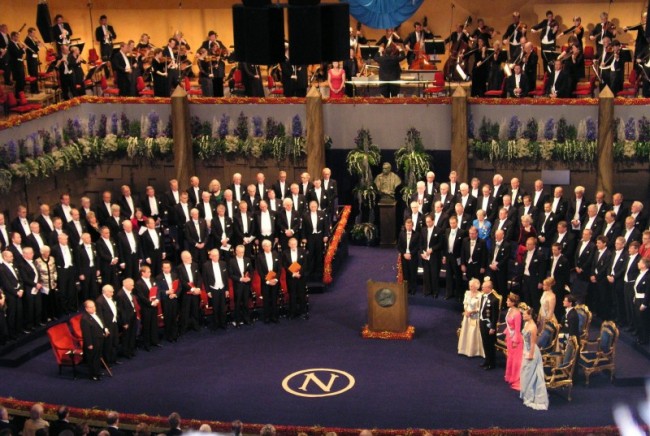Epigraph: Thou sees not, in the creation of the All-merciful any imperfection. Return thy gaze, seest thou any fissure. Then Return thy gaze, again and again. Thy gaze, Comes back to thee dazzled, aweary.’ (Al Quran 67:4-5)
Nobel Prize Ceremony
Written and collected by Zia H Shah MD
In 1979, when talking about religion and God was a taboo, in many scientific circles, Dr. Abdus Salam did not shy away from making a case of Deism, of a Creator God, in his Nobel speech. He recited a few verses of the Holy Quran, the translation of which, I have used as an epigraph of this article.
How could Salam, be miserly in thanking God, when he saw special Providence of God in his whole career? He often would go back to 1946, in his conversation, a year before partition of the sub-continent into India and Pakistan. He had finished his education in Lahore and was waiting for some break through. It came in the form of a scholarship.
Salam got to Cambridge by means of a scholarship from Small Peasants’ welfare fund which was set up by the Prime Minister of the combined state of Punjab, later to be the East and the West Punjab.
Salam got one of those scholarships and the interesting thing is that only five scholarships were offered, and the other four people who got them could not get university admission that year. Then came the partition of the country and the scholarships disappeared. So the entire purpose of that fund and those scholarships seemed to be to get Dr. Abdus Salam to Cambridge and the rest is history.
In Cambridge, he took a BA (honors) with a double First in mathematics and physics in 1949. In 1950 he received the Smith’s Prize from Cambridge University for the most outstanding pre-doctoral contribution to physics. He also obtained a PhD in theoretical physics at Cambridge; his thesis, published in 1951.
Salam’s belief in the Unity of God, gave him the inspiration that the four basic forces in the universe, gravitational force, weak nuclear force, strong nuclear force and electromagnetic force, in their basic essence, have to be one. He shared 1979 Nobel prize in physics with two other scientists for unifying the weak nuclear force and electromagnetic force.
Two scientists have won the Nobel prize in physics, in 2013, for their work on the theory of the Higgs boson.
Peter Higgs, from the UK, and Francois Englert from Belgium, shared the prize.
In the 1960s they were among several physicists who proposed a mechanism to explain why the most basic building blocks of the Universe have mass.
The Higgs boson, or the “God particle,” which was discovered last year, garnered two physicists the Nobel Prize in physics on Tuesday, October 8, 2013, but it didn’t go to the scientists who detected it.
Nearly 50 years ago, Francois Englert of Belgium and Peter Higgs of the United Kingdom had the foresight to predict that the particle existed.
Higgs and Englert’s theories behind the elusive Higgs boson explained what gives matter its mass.
The mechanism predicts a particle – the Higgs boson – which was finally discovered in 2012 at the Large Hadron Collider at Cern, in Switzerland.
But, what does Dr. Abdus Salam has to do with the Higgs boson?
Prof. Jerome Gauntlett, head of theoretical physics at Imperial College London, said in 2012, “The discovery of the Higgs boson is a truly great moment for science.
Its origins go back to the 1960s with enormous contributions made by Peter Higgs in Edinburgh and by Tom Kibble and Nobel Laureate Abdus Salam at Imperial.”
Pervez Amirali Hoodbhoy, a Pakistani nuclear physicist, a PhD from MIT, who was the professor of nuclear and high-energy physics, and also the head of the Physics Department at the Quaid-e-Azam University, explains Salam’s contribution further:
A bit of history: Peter Higgs of Edinburgh University had discovered in the 1960′s a very general principle by which elementary particles could go from being massless to having mass. But it was just a nice mathematical idea and no one knew what this had to do with the actual particles that constitute the world we happen to live in. Then, working separately on different continents, Steven Weinberg and Abdus Salam realized that if a Higgs particle of the right kind actually existed then everything we know about particles like the electron and quark could be understood within overarching theory. Their theory is called the Glashow-Salam-Weinberg model, or “Standard Model” of particle physics. This is just about the most important discovery in physics in the last 40 years. (Sheldon Glashow of Harvard didn’t have anything to do with the Higgs particle; his Nobel Prize work was important in a different way.)
I might mention that there are all kinds of Higgs particles in physics (e.g. in superconductivity), but they don’t all have to do with fundamental physics. The Higgs discovered at CERN was the Weinberg-Salam Higgs.
There is something else also that Dr. Abdus Salam has in common with Prof. Peter Higgs. Dr. Salam won the Edinburgh Medal in the inaugural year, in 1989 and Peter Higgs was its recipient in 2013.
The Nobel Prize website says about Dr. Abdus Salam:
Abdus Salam is known to be a devout Muslim, whose religion does not occupy a separate compartment of his life; it is inseparable from his work and family life. He once wrote: ‘The Holy Quran enjoins us to reflect on the verities of Allah’s created laws of nature; however, that our generation has been privileged to glimpse a part of His design is a bounty and a grace for which I render thanks with a humble heart.’
For a simplified documentation of these historic facts, about Higgs boson, turn to this short CNN video, from 2012:


